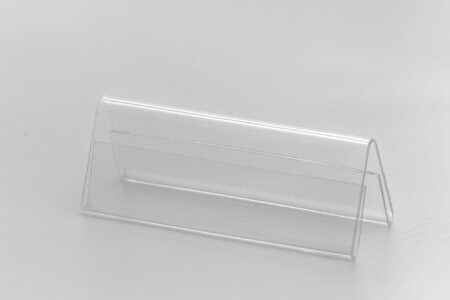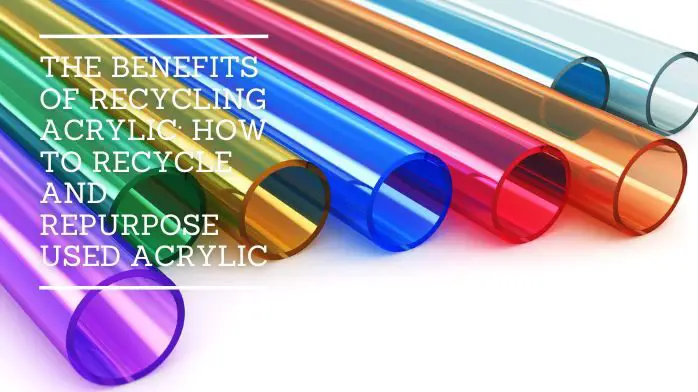Yes, acrylic can be recycled. However, it is not as commonly recycled as other materials such as aluminum or glass because it is more difficult to process, and there is less demand for recycled acrylic.
The recycling process for acrylic involves grinding the material into small pellets, which can then be used to create new products. It is important to note that not all recycling facilities accept acrylic, so it may be necessary to research to find a facility that can recycle it.
How to Recycle Acrylic
There are a few steps that you can take to recycle acrylic:
- Find a recycling facility that accepts acrylic. As I mentioned before, not all recycling facilities accept acrylic, so it is essential to find one that does. You can search online or call local recycling facilities to see if they accept acrylic.
- Clean and dry the acrylic. Before recycling acrylic, removing any dirt, dust, or other contaminants from the surface is essential. You can use soap and water to clean the acrylic or a mild detergent if the acrylic is particularly dirty. Once the acrylic is clean, ensure it is dry before moving on to the next step.
- Cut the acrylic into smaller pieces. To make recycling easier, cutting the acrylic into smaller pieces is best. You can use a saw or a jigsaw to cut the acrylic into smaller sections.
- Take the acrylic to the recycling facility. Once the acrylic is clean, dry, and cut into smaller pieces, you can take it to the recycling facility. Make sure to follow any guidelines or instructions the facility provides for properly recycling acrylic.
Remember that the process for recycling acrylic may vary depending on the specific recycling facility you use. It is always a good idea to contact the facility ahead of time to confirm their recycling process and to ask any questions you may have.

Where to Recycle Acrylic
There are a few options for finding a place to recycle acrylic:
- Contact your local recycling center. Many cities and towns have a local recycling center that accepts a wide range of materials, including acrylic. You can call your local recycling center to see if they accept acrylic and ask about their recycling process.
- Check with plastic recycling companies. Some companies specialize in recycling plastic, including acrylic. You can search online for plastic recycling companies in your area and contact them to see if they accept acrylic.
- Look for a specialized recycling facility. In some cases, you may be able to find a facility that specializes in recycling specific types of materials, such as acrylic. You can search online or contact local recycling organizations to see if they know of any facilities in your area that specialize in recycling acrylic.
It is also worth checking with manufacturers or retailers of acrylic products to see if they have any recycling programs. Some companies may have their recycling programs or may be able to point you in the direction of a facility that can recycle acrylic.
The Impact of Recycling Acrylic
Recycling acrylic can have several positive environmental impacts:
- Reduces waste: Recycling acrylic helps to reduce the amount of waste that ends up in landfills. When acrylic is sent to a landfill, it can take hundreds of years to break down, contributing to overfilled landfills. By recycling acrylic, we can reduce the amount of waste in landfills and help conserve natural resources.
- Reduces greenhouse gas emissions: The production of acrylic requires energy, which can result in the release of greenhouse gases into the atmosphere. When acrylic is recycled, it requires less energy to process, which means fewer greenhouse gases are emitted.
- Conserves natural resources: Acrylic production requires using natural resources, such as oil and natural gas. By recycling acrylic, we can save these resources and reduce the demand for a new acrylic, which can help to preserve these resources for future generations.
- Creates new products: When acrylic is recycled, it can create new products, such as plastic sheets, pipes, and other products. This helps reduce the demand for new acrylic and creates new economic opportunities.
Recycling acrylic can help reduce waste, conserve natural resources, and reduce greenhouse gas emissions, contributing to a more sustainable future.
Repurposing Used Acrylic
There are many ways to repurpose used acrylic, depending on the condition of the material and your creativity! Here are a few ideas:
- Use it as a base for a DIY project. If the acrylic is in good condition, you can use it as a base for a DIY project, such as building a tabletop or creating a custom frame for a piece of art.
- Donate it to a school or community center. Schools and community centers often have programs or projects that could use acrylic sheets or other materials. Consider donating your used acrylic to a local school or community center.
- Use it as a stencil. If the acrylic is thin and flexible, you can use it as a stencil for various crafts, such as painting, drawing, or scrapbooking.
- Turn it into a planter. If you have a piece of acrylic that is large enough and in good condition, you can use it as a planter. Simply drill holes in the bottom of the acrylic for drainage and fill it with soil and plants.
- Use it as a protective cover. If you have a piece of acrylic that is large enough, you can use it as a protective cover for outdoor items, such as grills or outdoor furniture. This can help extend these items’ life by protecting them from the elements.
These are just a few ideas, and there are many other ways you can repurpose used acrylic, depending on your needs and creativity.
Conclusion
Acrylic is a type of plastic that can be recycled, although it is not as commonly recycled as other materials. The recycling process involves grinding the material into small pellets, which can then be used to create new products.
You can take a few steps to recycle acrylic, including finding a recycling facility that accepts it, cleaning and drying it, cutting it into smaller pieces, and taking it to the recycling facility. Recycling acrylic can have several positive environmental impacts, including reducing waste, reducing greenhouse gas emissions, conserving natural resources, and creating new products.
Suppose you are unable to recycle your acrylic. In that case, there are also many ways you can repurpose it, such as using it as a base for a DIY project, donating it to a school or community center, using it as a stencil, turning it into a planter, or using it as a protective cover.

